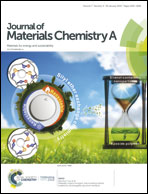The top-down synthesis of sequentially controlled architectures for honeycomb-layered Na3Ni2BiO6 towards high-voltage and superior performance cathodes for sodium-ion batteries†
Abstract
Tailoring materials into nanostructures is triggering unprecedented innovation through the realization of their functional properties. Fast kinetics and superior properties are especially important in the fields of energy storage and conversion. However, owing to the limited synthetic methods available, the controllable construction of diverse architectures of honeycomb-layered transition metal oxides has been rarely reported. Herein, we report a novel top-down strategy to sequentially control the architectures of a honeycomb-layered Na3Ni2BiO6 oxide. The “top” precursor, i.e. the 1D nanofibers, was prepared via an electrospinning technique, and the “down” product, i.e. the honeycomb-layered oxide, was obtained after removing the polymer carrier in subsequent pyrolysis. A series of architectures, from aggregated microsize particles to dispersed nanoscale particles to hierarchical fibers, were constructed through adjusting the synthetic conditions. The evolution mechanisms of the different architectures were then probed. Moreover, the relationship between the external architecture, the internal microstructure, and the sodium intercalation capability of the Na3Ni2BiO6 oxides is then clarified. Taking the advantages of the nanoscale primary crystals, all the products were observed to have enhanced properties over those of a reference sample from solid-state synthesis. Moreover, the loose connections between the particles resulted in a porous structure for both the dispersed nanoparticles and the hierarchical fiber products, ensuring their fast sodium transport capabilities and super rate properties. Therefore, this research not only provides a new strategy for the controllable construction of diverse architectures for electrode materials, but also propels the development of a new class of high-voltage and superior performance cathodes for use in advanced sodium-ion batteries.



 Please wait while we load your content...
Please wait while we load your content...